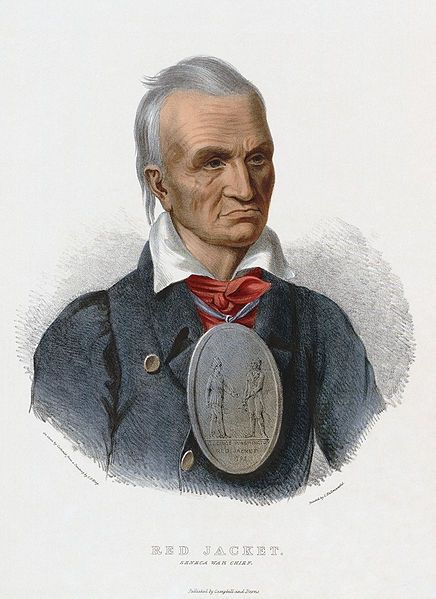
In 1830 Red Jacket, the most famous Seneca orator, died in New York at the age of 74. Seneca writer, historian, and archaeologist Arthur Caswell Parker described the deathbed scene this way:
“He murmured that his old comrades were around him, some chiding him for his mistakes and urging him to see that there was a task ahead.”
Red Jacket was born to the Wolf Clan (since the Seneca are matrilineal he belonged to his mother’s clan) and was given the name Otetiani (“He is Prepared”) and took the name Sagoyewatha (“He Causes them to be Awake”) when he became a chief. His English name, Red Jacket, came from the scarlet coat given to him by the English for fighting on their side during the Revolutionary War.
At the beginning of the Revolutionary War Red Jacket argued for neutrality, but the Seneca, Mohawk, Onondaga, and Cayuga-all part of the larger Iroquois Confederacy-decided to support England. He served with the British forces. During the war he served primarily as a dispatch courier.
During the Revolutionary War, animosity developed between Red Jacket and the Mohawk leader Joseph Brant. Brant alleged that during the Battle of Newtown in 1779, when the Seneca and the Mohawk were allied with the British, Red Jacket had killed a cow, then used the blood to claim that he had killed an American rebel. In the years that followed, Brant would contemptuously refer to Red Jacket as “cow killer.”
Red Jacket became the principal spokesperson for the Seneca following the Revolutionary War.
After the Revolutionary War, the United States assumed that since it had defeated the British it had earned the right to superimpose a series of treaties on the Indian nations. In 1784, American negotiators met with the Indian nations of the Iroquois Confederacy at Fort Stanwix. The Americans refused to recognize the Iroquois Confederacy (Six Nations) and insisted on dealing with each nation by itself. The American negotiators were aided by force of arms and by hostages to be used in negotiating the treaty terms. One notable leader was absent from the Fort Stanwix council: the Seneca sachem Red Jacket. According to Arthur Caswell Parker:
“Red Jacket remained aloof, not caring to face the humiliation that would be heaped upon his disorganized and distracted people.”
In 1791, the federal government held a council with the Iroquois Six Nations. The American emissary, Timothy Pickering, pressured the Iroquois to provide the United States with warriors for the Indian wars in Ohio. Pickering boasted of American military supremacy and unwittingly insulted the Iroquois. For the Iroquois, public councils were settings which were meant to nurture a friendly, peaceful frame of mind. Councils were to build consensus. This error created an opportunity for Seneca leader Red Jacket to utilize oratory and to create an image for himself as the conservator of hallowed traditions.
In 1792, Red Jacket was among a number of Iroquois leaders who met with President George Washington in Philadelphia. Here he received a large silver medal.
That same year, three Seneca chiefs-Red Jacket, Cornplanter, and Farmer’s Brother-attended a council in Ohio with the Shawnee, Miami, Delaware, and Wyandot in which they presented a peace proposal from the Americans. Shawnee leader Painted Pole reminded the Seneca that while the Iroquois were doing nothing, the Shawnee and their allies had defeated the American army twice. Ridiculing the Seneca, the Shawnee hurled the written copy of the American peace proposal into the fire.
In 1794, Red Jacket along with 50 other Iroquois leaders signed the Treaty of Canadaigua in which they ceded much of their land to the United States.
In 1801, the Seneca Council debated the possible sale of a strip of land along the Niagara River to the Americans. The prophet Handsome Lake opposed the sale on the grounds of revelations given to him by angels. His nephew Red Jacket, the speaker of the Seneca Nation, favored the sale. Handsome Lake accused Red Jacket of witchcraft and Red Jacket accused Handsome Lake of manufacturing his visions.
In 1802, a Seneca known as Stiff-Armed George got into a drunken fracas outside of a tavern. He was beaten and pursued, but then pulled a knife and stabbed two non-Indian men, one fatally. Reluctantly, the Seneca chiefs surrendered him to New York state authorities. According to Seneca leader Red Jacket:
“Did we ever make a treaty with the state of New York, and agree to conform to its laws? No. We are independent of the state of New-York.”
He then presented the state’s governor with a copy of the Treaty of Canandaigua which clearly placed the case in federal jurisdiction. However, the governor wanted to prove state jurisdiction over all of the Indians in New York and the federal government declined to intervene.
In 1805, Seneca chief Red Jacket responded to a Christian missionary’s proposal to convert his people:
“You have got our country, but are not satisfied; you want to force your religion upon us.”
He went on to say:
“We are told your religion was given to your forefathers and has been handed down from father to son. We also have a religion which was given to our forefathers and has been handed down to us, their children. We worship in that way. It teaches us to be thankful for all the favors we receive, to love each other, and to be united. We never quarrel about religion.”
He told the missionary:
“Brother, we do not wish to destroy your religion or take it from you. We only want to enjoy our own.”
War broke out between England and the United States in 1812. In New York, the Americans call together a council of the Iroquois nations. The Americans invite the Iroquois to join them in their war against the British. Seneca leader Red Jacket told the Americans:
“My people care more for peace than for war.”
According to Arthur Caswell Parker:
“Though Red Jacket argues for the neutrality of his people, he clearly declared their loyalty to the United States.”
Red Jacket argued against joining the British and urged his people to ally themselves with the Americans. When the Seneca declared war against the British, Red Jacket became a captain in the United States Army.
In 1816, the Iroquois Six Nations met with the Shawnee, Ottawa, and Wyandot in Ohio to discuss the possibility of the removal of the New York tribes to Ohio. Mohawk leader Joseph Brant felt that it would be a good idea for the Seneca to move to Sandusky where they could join with the Wyandot. Arthur Caswell Parker described the council:
“The chiefs of the Six Nations, long accustomed to the clothing of the white man, were once more dressed in their ancient costumes.”
Seneca leader Red Jacket addressed the council and reminded them that those tribes who recently sided with the British had lost a great deal. Red Jacket told them:
“We have always lost by taking up the hatchet. Even the British, upon whom we pinned our hopes, sold our land to the Americans after every war in which we were allied with them.”
Red Jacket spoke against selling land to the Americans:
“To command respect, you must possess extensive territory! Keep your holdings sufficiently large so that you may not be crowded on any side by the whites.”
In 1819, the Ogden Land Company, with the approval of the federal government, met with the Seneca to discuss buying their land. To watch out for the best interest of the Indians, the government appointed two agents to make sure that the Indians were not cheated or deceived. The Seneca chiefs-Little Billy, Red Jacket, Tall Chief, Young King, Two Skies, Infant, and Destroy Town-listened to the offer which was expressed in glowing terms about its benefit to the Seneca. One of the agents appointed by the government told the Seneca that the President James Monroe felt that it was in their best interest to sell their lands. The Seneca gave in and sold their land for 55 cents an acre and the land company quickly resold it for many times that amount. Arthur Caswell Parker wrote:
“Federal commissioners, delegated to prevent ‘cheating of the Indians,’ entirely forgot that they might have insisted upon a much higher compensation at a public sale, the profits of which could have been used to benefit these Indians for many years.”
In 1821, the Seneca tribal council convicted Kauquatou of sorcery. Acting on behalf of the tribal council Chief Tommy-Jemmy cut Kauquatou’s throat. In response, the state of New York prosecuted Tommy-Jemmy for murder. Red Jacket and Tommy-Jemmy’s court-appointed attorneys argued that the death of Kauquatou was not murder under New York law because it was a legal execution under Seneca law, on Seneca land, by the sovereign Seneca people. The circuit court referred the case to the New York State Supreme Court which noted that no law extended state murder jurisdiction over the Iroquois.
By 1824, Red Jacket was considered the leader of the Seneca Pagan Party which advocated traditional ways and which opposed both the Long House religion of Handsome Lake and European Christianity.
In 1827 Red Jacket traveled to New York City to talk with the Quakers about providing aid for his people. According to Arthur Caswell Parker:
“Red Jacket trusted few persons other than the stalwart Quakers, who could not be intimidated and who were quick to expose a fraud.”
However, the Quakers were involved with helping the Onondaga and did not have any resources with which they could respond to the Seneca request.
While in New York City, Red Jacket agreed to have his portrait painted by R. W. Weir, one of the noted artists of the city. In posing for the painting, Red Jacket dressed in a costume which he felt was appropriate: a caped coat with braid and tassels, a red sash, his Washington medal, and his pipe tomahawk.
In 1827, the Seneca deposed Red Jacket as chief because of his alcoholism and his inflexible political views. Part of the opposition to him stemmed from his involvement with the Pagan Party.
In 1829, Red Jacket once again asked the Quakers for aid. The Quakers provided the Seneca with both farm equipment and sound advice.
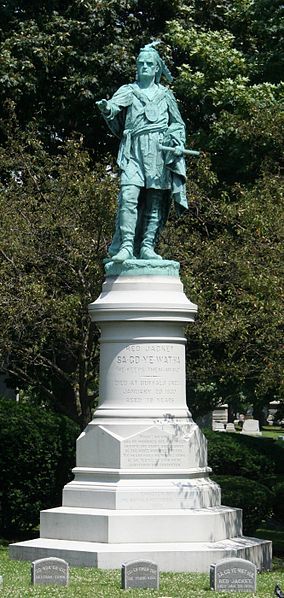
Shown above is the Red Jacket Monument at the Forest Lawn Cemetery in Buffalo, New York. In 1884, Red Jacket’s remains were reburied at this cemetery. Against his wishes, Red Jacket was given a Christian burial.
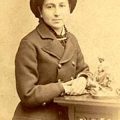
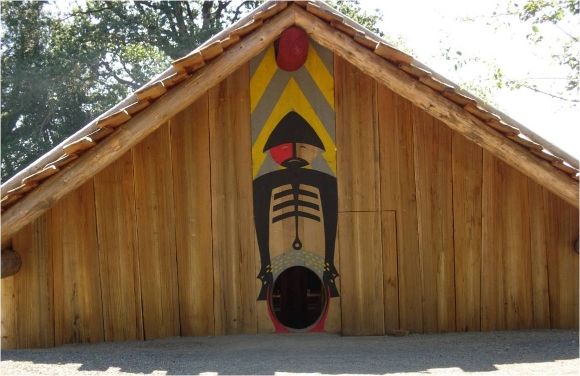
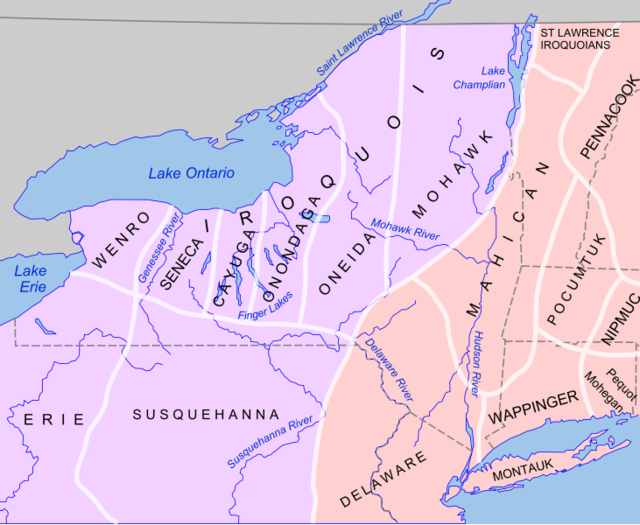
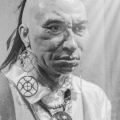
Leave a Reply